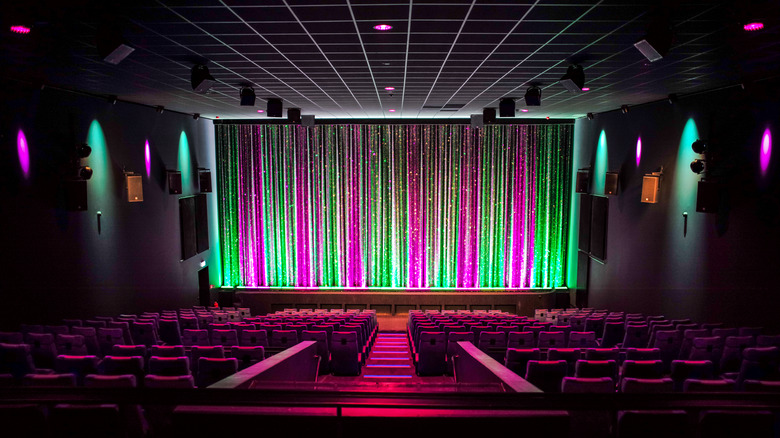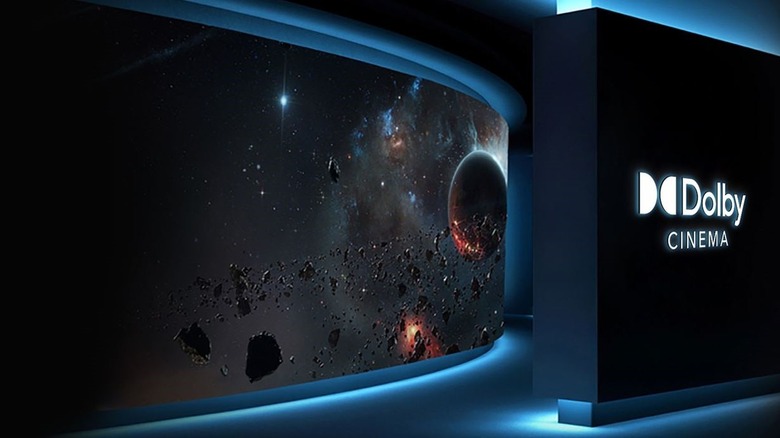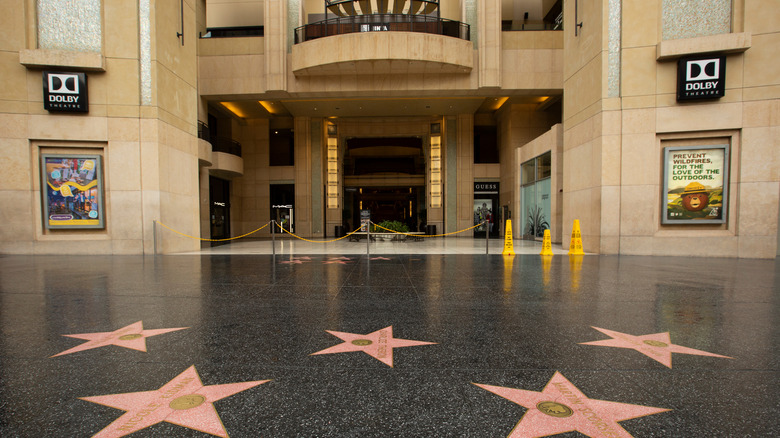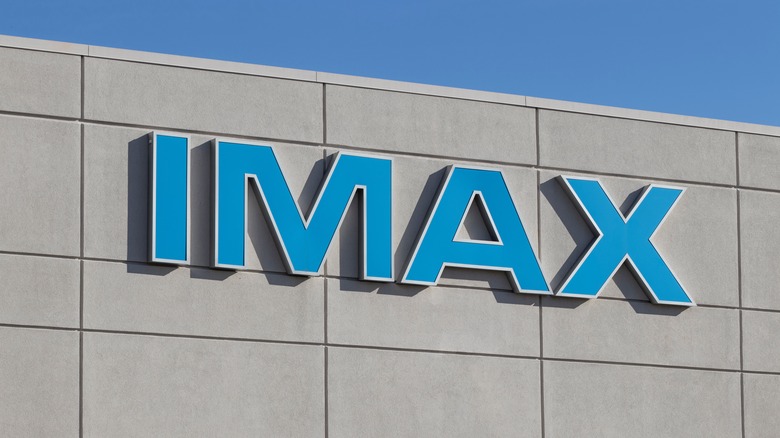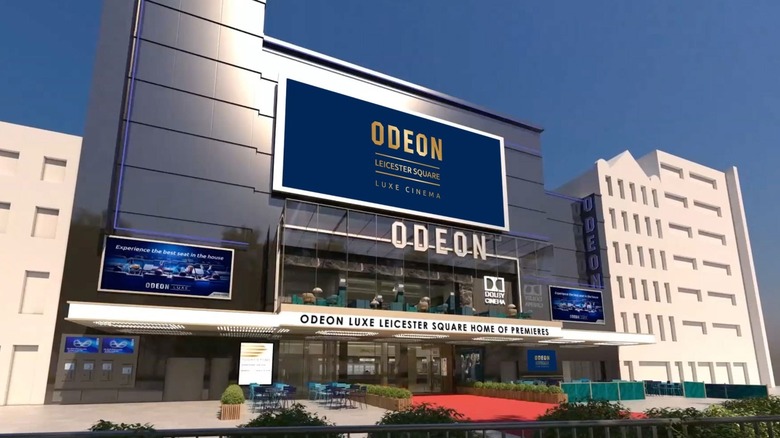What Is Dolby Cinema And Where Can You Watch It?
We may receive a commission on purchases made from links.
Been to a movie theater recently? It's a confusing affair, and we don't mean deciding what to watch. There's premium this, premium that, acronyms aplenty, and ticket prices keep going up.
Part of that is because the streaming service wars have intensified, with movies often getting digital releases soon after the theatrical release. Universal Pictures and Dreamworks titles are coming to Peacock within months, and WarnerMedia started rolling out hybrid releases in theaters and on HBO Max on the same day.
Multiple new, premium moviegoing options have been created to tempt people out of their homes and into the theaters. One of these is Dolby Cinema, found at AMC theaters in the U.S. and various other chains worldwide.
Created by Dolby Laboratories, it was designed to turn cinema-going into a "transformative experience." But what does that entail, and why should you try to find a Dolby Cinema theater near you for your next movie-watching experience?
What is Dolby Cinema?
Dolby Cinema is comprised of two main Dolby Labs proprietary technologies, Dolby Vision and Dolby Atmos. The system also requires signature tweaks to the building where the screen is installed.
The newer of the two core technologies, Dolby Vision, is a proprietary standard for High Dynamic Range (HDR) that Dolby first introduced in 2014. It uses dynamic metadata for per-frame control over the original HDR recording.
Crucially, the dynamic metadata means that content created with Dolby Vision will adjust itself to best match the characteristics of the display it is shown on. Dolby says this means what creators see on the editing screens is "what will be seen on the screens of their viewers on Dolby Vision enabled devices."
Dolby Atmos was first installed in a theater for the June 2012 premiere of the Disney-Pixar animated film "Brave." The specification expands on the prior surround-sound systems of 5.1 and 7.1 speaker set-ups by adding channels from overhead to add height to the sound. The technology can simultaneously create individual sound objects, up to 118, and place them in 3D space around the listener.
The interesting thing about Dolby Cinema is that it was designed to be future-tolerant. Dolby Vision supports 12-bit colors, 8K resolutions, and 10,000 nits peak brightness, specifications that even the most expensive TVs will struggle to match.
How does Dolby Cinema work?
To create the Dolby Cinema experience, cinemas must create dedicated screening rooms. That's partly to house the technology enabling Dolby Vision and Dolby Atmos and some additional physical requirements for the immersive experience Dolby designed.
Dolby specifies that dual HDR RGB 4K resolution laser projectors are necessary. There are two main key points to Dolby Cinema for image quality.
First, the dual-projector setup is about twice the brightness of a standard cinema system. That also enables bright Dolby 3D capabilities without the darker picture typical of 3D movies.
The second point is improved control of black levels. Laser projectors have directed light, so they don't suffer from the grayish blacks of bulb-based projectors.
Typical cinema projectors might have a contrast level of 2000:1. Dolby Cinema projectors have a contrast ratio of 1,000,000:1. To create the immersive sound field of Dolby Atmos, the screening room also needs at least 64 speaker fields, with some locations using over 400 speakers.
Unlike traditional surround-sound channels, sounds are defined as individual objects. That means sound designers can move things like cars right past your seat. Up to 128 sound objects can be played simultaneously, building on the viewer's immersion.
The theater also needs to have luxury recliner seats for ultimate comfort. Those often have actuators in the seats, vibrating them in sync with onscreen action like explosions.
Even the entrance walkway to the screen is carefully crafted, with a video wall showing content related to the movie you are about to watch.
Benefits of Dolby Cinema
Dolby Cinema was designed to be a premiere movie-going experience and comes with a host of upsides.
The specifications set down for Dolby Vision result in an image quality they suggest is unmatched by any other cinema technology. The dual 4K projectors give twice the brightness, four times the resolution, and 500 times the contrast ratio of standard cinema screens.
The laser projectors also mean that anything on the screen that should be black will be black and not grayish. The projectors also feature improved color accuracy and vibrancy over traditional Xenon projectors.
Dolby Atmos is among the best surround-sound technologies, with a minimum of five in-screen speakers, four subwoofers, and 48 surround speakers per showroom. The object-based system brings a level of realism that's hard to match.
None of that matters if you're distracted by an uncomfortable seat. Dolby Cinema theaters have adjustable leather-clad recliners that vibrate to add another layer of realism to your experience.
Negatives of Dolby Cinema
Despite all the benefits Dolby Cinema brings, there are a couple of notable drawbacks.
The biggest one is the limited number of suitably-equipped cinema screens. Owing to the high hardware cost, only a handful of locations worldwide have Dolby Cinema certifications. The list is growing steadily, and the relatively new cinema standard has only been around since 2015.
There is also only a small list of theater chains partnering with Dolby to increase the number of Dolby Cinema locations. AMC is the chain in the U.S. where most properly-equipped screens are located.
Cost also affects the number of movies available on the new system. Producing content with the relevant standards provides new technical challenges. That might change, as ProducersGuild.org says that "many producers are making one Dolby Vision and Dolby Atmos master, then generating versions for all markets and uses."
That sounds like we should expect to see more movies shown in Dolby Cinema in the future.
Tips for buying Dolby Cinema
Home theater hardware has progressed significantly since Dolby Cinema first appeared in 2015. That includes home versions of the laser projectors used for Dolby Vision, wide availability of Dolby Atmos-equipped audio and visual devices, and new technologies like OLED panels.
That made us wonder if you could recreate a Dolby Cinema experience at home.
We were fortunate to talk to Jed Harmsen, Head of Cinema & Group Entertainment at Dolby Laboratories, to get his take on how immersive an at-home theater setup could be.
His response was encouraging, outlining how straightforward it is for consumers to get devices with Dolby Vision, Dolby Atmos, or both without needing a specialty retailer. He also outlined Dolby's efforts in making their technologies more accessible, from streaming services, TV networks, movie producers, and even games, music, and live sports.
That sounds like you could recreate the theater-going experience at home, but specifications only tell part of the story. He likens the theater experience to attending a concert instead of listening to the album at home–they are "completely different classes of experiences."
Amazon's Omni Series 4K UHD smart TVs provide a low-cost entry point to the world of Dolby Vision-equipped TVs. Sonos' range of smart speakers brings Dolby Atmos to your room, either as a soundbar to put next to your TV, or in-wall installations. You'll also need access to a streaming service that supports both, like Netflix, Apple TV, or Disney+.
A (short) History of Dolby Cinema
The first physical Dolby Cinema screen opened in the Netherlands on December 15, 2014. The journey to that point took substantially longer than the eight-screen JT Eindhoven complex took to build.
Since IMAX first came onto the scene in the 1970s, theater companies have worked to create a competing premium format. Dolby Laboratories was already the premier brand for theater sound, but it wanted more.
In 2012, Dolby Atmos immersive sound had been installed in 700 theaters worldwide. At that time, IMAX was in 800 locations, and Dolby wanted a piece of that.
It was another two years before Dolby was ready, with Dolby Vision and the other theater design elements that would create the immersion of Dolby Cinema.
The biggest change was in the high dynamic range that the new system promised, with filmmakers like Oscar-winning cinematographer Emmanuel Lubezki eager to use the new technology. Dolby Vision for TV was also rolled out that year for home use.
We couldn't discuss the history without mentioning the flagship Dolby Theatre on Hollywood Boulevard. It uses both Dolby Vision and Dolby Atmos and is possibly best known for being the venue for Hollywood's biggest night — the Oscars.
Dolby Cinema's partnership with AMC
In the U.S., where most Dolby Cinema screens are located, you can only find them at the theater chain AMC.
Dolby Laboratories had what they thought was a winning premium format, but they didn't have any of their own cinema screens to put the technology into. Enter AMC, who are always looking for new technologies to give their screens the edge over their competitors.
AMC had its own premium theater experience, AMC Prime, which focused on comfortable seats, better digital projectors, and upgraded audio quality. What it didn't have was Dolby Vision, and the chain rapidly started converting its AMC Prime theaters to Dolby Cinema.
As part of the agreement, AMC renovated and converted all of its other premium theater experiences, ETX and AMC Prime, into Dolby Cinema screens.
That expansion went even faster than anticipated, with the original AMC promise of "up to 100 Dolby Cinema at AMC Prime locations by December 2024." There were already 127 Dolby Cinema locations in 2020, and more are on the way.
Dolby Cinema vs. IMAX
Dolby Cinema and IMAX are the two most popular large cinema formats. IMAX has been around for much longer, with the first IMAX film, "Tiger Child," shown at Expo '70 in Osaka, Japan.
Both formats produce an immersive experience for the viewer but differ in key areas. For a start, IMAX has many more locations worldwide, with over 1,500 theaters spread between 80 countries. Dolby Cinema has only 250 currently, with another 200 promised to be built.
The screens in IMAX theaters are generally larger, depending on the cinema. The largest ones are inside domes nearly 100 feet in diameter. Most are 60 x 80 feet, according to LF Examiner. According to Dolby, Dolby Cinema screens are generally a quarter of that area, with the one in the flagship Dolby Theatre being 60 x 30 feet.
Normal cinema screens have a brightness of 14 foot-Lamberts (fL). IMAX with laser increases that luminance by 50% to 22 fL, but Dolby Cinema has another 50% increase to 31 fL. That means the image at Dolby Cinema screens will be twice the brightness of normal screens.
IMAX uses a six-channel surround-sound system or a 12-channel one in the newer, laser-based screens. Dolby Cinema uses Dolby Atmos, with up to 400 speakers in one screening room.
Other alternatives to Dolby Cinema
While IMAX and Dolby Cinema are the two most widespread premium large formats for theater use, they have competition. Some of these other options were created by cinema chains, while others are licensing the technology.
One of the newest alternatives is Samsung's Onyx Cinema LED. This revolutionary theater experience doesn't use a projector at the back of the cinema or behind the screen. Instead, it uses self-emitting LEDs for each pixel to create a giant 4K screen. It's not quite a scaled-up QLED TV, but it's not far off it, and the individually controlled LEDs give it control over black levels that previously only OLED could match.
Almost any movie you've watched in 3D was projected on either IMAX 3D or RealD 3D. While the picture quality is on par with 2D digital projectors, RealD has no control over seating or audio quality, so sometimes, these can suffer.
4DX turns the auditorium into an amusement ride. Their screens feature moving seats, flashing lights, and other physical sensations from fans, water sprays, and more. Like at an amusement park, there is a whole list of safety guidelines to agree to before watching a 4DX movie.
The VOID is a crafted virtual reality experience that isn't a traditional movie experience but closer to a video game. The viewing room is built so you can touch physical things that interact with the VR experience, and additional realism comes from wind and scent effects.
How many Dolby Cinema-equipped theaters are operational?
With the sheer amount of specialized hardware needed for a Dolby Cinema-equipped screen, theater chains can't put one in every location.
Dolby says over 450 Dolby Cinema sites are "open or committed." The mix includes over 250 existing sites, and another 200 planned to open. That number also includes one at Dolby Laboratories' U.S. headquarters.
The first UK Dolby Cinema location was at Odeon Leicester Square, where architects had to retrofit massive amounts of technology into a two-tier auditorium. That single screen has 410 Dolby Atmos speakers dotted around the interior, connected by ten miles of heavy-duty speaker cable.
In the U.S., the only place to find Dolby Cinema in all its glory is at AMC. The chain opened its 100th Dolby Cinema location in 2018 and has over 120 across the U.S.
The other countries with Dolby Cinema theaters are China, Japan, the United Arab Emirates, the U.K., Austria, France, the Netherlands, and Spain. That's not many locations when you consider IMAX has over 1,500 theaters spread over 80 countries.
The Dolby numbers skyrocket when you add those theaters that support Dolby Atmos but not the rest of the Dolby Cinema requirements. Over 6,900 of those are available worldwide.
Which movies can I watch in Dolby Cinema?
Impressive hardware is one thing, but you need blockbuster content to watch on it. Blockbuster movies are often edited into the many competing audio-visual standards, including Dolby Cinema.
We asked Jed Harmsen, Head of Cinema & Group Entertainment at Dolby Laboratories, what his favorite movie recorded in Dolby Cinema was: "One film that really blew me away in Dolby Cinema this summer was "Top Gun: Maverick." Beyond the obvious nostalgia I felt as a huge fan of the original "Top Gun," the enveloping sounds of the jet engines, the stellar soundtrack, the visual detail in the aircraft, and even the in-flight dialogue — it's a movie that feels destined to be experienced in Dolby Atmos and Dolby Vision to really be immersed in that world."
Fans of the Marvel Cinematic Universe will want to check if they have a Dolby Cinema screen near them. Every upcoming release, from "Black Panther: Wakanda Forever" to "Aquaman and the Lost Kingdom," will be mastered in" Dolby Cinema.
So will "The Super Mario Bros. Movie," "The Flash," "Spider-Man: Across the Spider-Verse," and "Black Adam." And so will James Cameron's "Avatar: The Way of Water."
Two notable new releases that won't be in Dolby Cinema are the reissues of 1982's "E.T. The Extra-Terrestrial" and 1975's "Jaws." Those were remastered into IMAX and RealD 3D.

